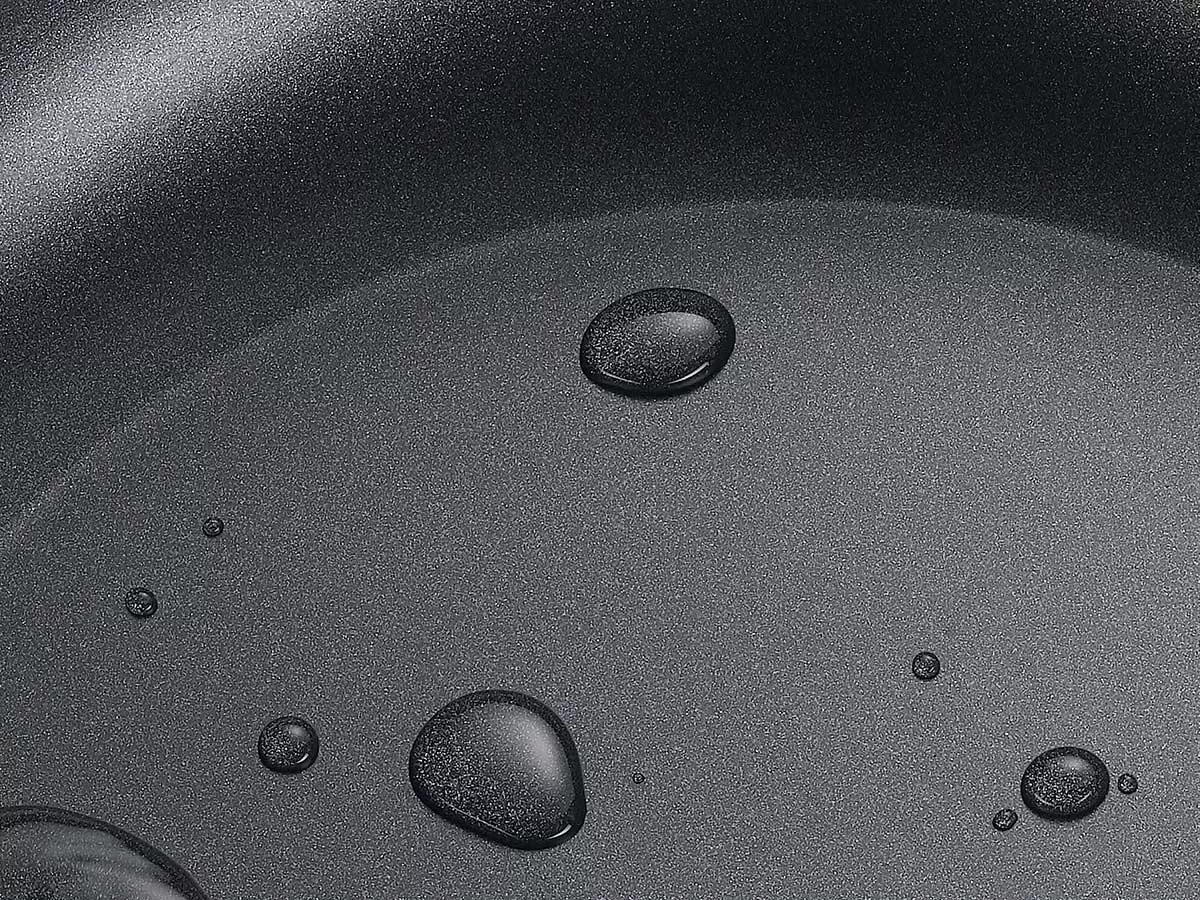Understanding Non-Stick Coatings
Non-stick coatings are special layers applied to cookware that help food slide off easily. These coatings make cooking and cleaning much simpler. There are several types of non-stick coatings, each with its own features and benefits.
Types of Non-Stick Coatings
- PTFE (Teflon): This is the most common type, known for its excellent non-stick properties.
- Ceramic: Made from silica, ceramic coatings are considered safer but may not last as long as PTFE.
- Anodized Aluminum: While not technically non-stick, it offers a tougher surface that resists sticking.
How Non-Stick Coatings Work
Non-stick coatings work by creating a smooth surface that reduces friction. This means food doesn’t stick as easily, making cooking and cleaning easier. The coatings are usually applied in multiple layers, similar to paint.
Common Materials Used in Non-Stick Coatings
| Material | Durability | Safety Concerns |
|---|---|---|
| PTFE (Teflon) | Moderate | Can release fumes at high heat |
| Ceramic | Low | Less durable than PTFE |
| Anodized Aluminum | Moderate | Generally safe |
Non-stick pans won't last forever. Here's your guide to the general lifespan of non-stick cookware, along with when to know it's time to replace them.
Understanding these coatings helps you choose the right cookware for your kitchen needs. Each type has its pros and cons, so consider what works best for you!
Factors Affecting the Lifespan of Non-Stick Coatings
Non-stick coatings are popular for their convenience, but their lifespan can vary significantly based on several factors. Understanding these can help you make the most of your cookware.
Heat Exposure and Its Effects
- Avoid overheating: High temperatures can damage the non-stick surface.
- Use low to medium heat: This helps maintain the coating's integrity.
- Prevent thermal shock: Don’t move a hot pan to cold water suddenly.
Impact of Cooking Utensils
- Choose wisely: Use wooden or silicone utensils to avoid scratches.
- Avoid metal utensils: They can easily damage the non-stick layer.
- Gentle handling: Be careful when stirring or flipping food.
Role of Cleaning and Maintenance
- Hand wash only: Use mild soap and a soft sponge to clean.
- Avoid abrasive tools: Steel wool can scratch the surface.
- Store properly: Use pan protectors to prevent scratches when stacking.
Proper care can significantly extend the lifespan of your non-stick cookware. Remember, while most non-stick pans last an average of two to three years, pans of a poorer quality may yield fewer uses before the non-stick coating wears off.
Comparing Different Non-Stick Coating Materials
PTFE vs. Ceramic Coatings
PTFE (Teflon) and ceramic coatings are the two most common types of non-stick surfaces. PTFE coatings are known for their durability, often lasting between one to five years with proper care. However, they can break down at high temperatures, typically around 500°F (260°C). In contrast, ceramic coatings are made from silica and are considered safer, as they do not contain toxic chemicals like PFOA. Yet, they tend to be less durable, often lasting only one to three years.
Advantages of Anodized Aluminum
Anodized aluminum is not a traditional non-stick coating but rather a process that strengthens the aluminum surface. This makes it tougher and non-reactive, which is great for cooking acidic foods. However, it is important to note that anodized aluminum will not develop a non-stick surface over time like cast iron or carbon steel. Here are some key points about anodized aluminum:
- Durable surface that resists scratches.
- Non-reactive with acidic foods.
- Not truly non-stick, so it may require more oil or fat when cooking.
Durability of Enamel-Coated Cast Iron
Enamel-coated cast iron is another option that offers excellent durability. This type of cookware can last for generations if maintained properly. It provides a non-stick surface without the risk of harmful chemicals leaching into food. Here are some benefits of enamel-coated cast iron:
- Long-lasting and can withstand high temperatures.
- Easy to clean and maintain.
- Versatile for various cooking methods, including stovetop and oven.
Enamel-coated cast iron combines the benefits of non-stick cooking with the durability of traditional cast iron, making it a great choice for many home cooks.
In summary, when comparing non-stick coating materials, consider factors like heat resistance, durability, and safety. Each type has its pros and cons, so choose based on your cooking style and needs.
Proper Care and Maintenance of Non-Stick Cookware
Cleaning Techniques for Longevity
To keep your non-stick cookware in great shape, it's safest to use a soft sponge when cleaning your pan. Here are some tips:
- Always wash your pan with soap and water after each use.
- Avoid using metal utensils; opt for wooden or silicone instead.
- Steer clear of abrasive scrubbers like steel wool, as they can scratch the surface.
Best Practices for Cooking
When using non-stick pans, follow these guidelines to extend their lifespan:
- Use low to medium heat to prevent overheating.
- Never preheat an empty pan; always add oil or food first.
- Avoid thermal shock by not placing a hot pan under cold water.
Storage Tips to Prevent Damage
Proper storage is essential to maintain your non-stick cookware:
- Place a paper towel or cloth between stacked pans to prevent scratches.
- Store pans in a cool, dry place to avoid moisture buildup.
- Avoid stacking heavy items on top of your non-stick cookware.
Following these care instructions can help your non-stick cookware last longer and perform better, ensuring a reliable cooking experience.
Health and Safety Considerations
Potential Risks of PTFE Coatings
Non-stick pans often use PTFE, commonly known as Teflon. While it is generally safe for cooking at normal temperatures, overheating can release harmful fumes. Studies have shown that these fumes can lead to serious health issues, including respiratory problems. Additionally, there are concerns about the presence of PFAS, or "forever chemicals," in some non-stick coatings, which have been linked to various health problems.
Benefits of Non-Toxic Alternatives
Choosing non-toxic cookware can significantly reduce health risks. Here are some safer options:
- Ceramic cookware: Free from harmful chemicals and offers good non-stick properties.
- Stainless steel: Durable and non-reactive, making it a safe choice for cooking.
- Cast iron: When seasoned properly, it provides a natural non-stick surface without chemicals.
Regulatory Standards and Compliance
It's essential to be aware of the regulations surrounding non-stick cookware. Many countries have set standards to limit the use of harmful substances in cookware. Always check for compliance labels when purchasing non-stick products to ensure they meet safety guidelines.
Opting for non-toxic cookware not only protects your health but also contributes to a safer environment. By making informed choices, you can enjoy cooking without the worry of harmful chemicals leaching into your food.
Evaluating the Cost-Effectiveness of Non-Stick Cookware
Initial Cost vs. Longevity
When buying non-stick cookware, the initial price can vary widely. Here’s a quick comparison:
| Cookware Type | Average Price | Lifespan (Years) |
|---|---|---|
| PTFE Coated | $20 - $100 | 1 - 5 |
| Ceramic Coated | $30 - $150 | 3 - 7 |
| Anodized Aluminum | $40 - $200 | 5 - 10 |
| Enamel-Coated Cast Iron | $50 - $300 | 10+ |
Environmental Impact
Choosing non-stick cookware also affects the environment. Here are some points to consider:
- Durability: Longer-lasting cookware reduces waste.
- Material Safety: Non-toxic options minimize harmful chemical exposure.
- Recyclability: Many non-toxic materials can be recycled.
Long-Term Savings with Durable Options
Investing in higher-quality non-stick cookware can lead to savings over time. Consider these benefits:
- Fewer replacements: Durable cookware lasts longer, saving you money.
- Better cooking performance: High-quality pans often cook food more evenly.
- Healthier cooking: Non-toxic options reduce the risk of chemicals leaching into food.
Choosing the right non-stick cookware is not just about the price tag; it’s about value over time. A good pan can last for years, making it a smart investment for your kitchen.
In conclusion, while the upfront cost of non-stick cookware can be high, the long-term benefits often outweigh the initial expense. By selecting durable and safe options, you can enjoy cooking while also being mindful of your budget and the environment.
Expert Reviews and Consumer Feedback
Top-Rated Non-Stick Pans
When looking for the best non-stick pans, several brands stand out based on expert reviews and consumer feedback. Here are some of the top-rated options:
- GreenPan: Known for its durability and non-toxic materials, GreenPan has received praise for its long-lasting performance.
- Calphalon: This brand offers a variety of non-stick cookware that is both affordable and reliable.
- T-fal: Popular for its budget-friendly options, T-fal pans are often recommended for everyday cooking.
Common Consumer Complaints
While many consumers love their non-stick cookware, some common complaints include:
- Scratching: Many users report that their pans scratch easily, especially when using metal utensils.
- Peeling Coating: Some consumers have experienced the non-stick coating peeling off after a few months of use.
- Heat Resistance: A few users mention that certain pans do not hold up well under high heat.
Expert Tips for Choosing the Right Pan
To ensure you select the best non-stick cookware, consider these expert tips:
- Look for ceramic or anodized aluminum options for better durability.
- Always use wooden or silicone utensils to prevent scratching.
- Check for oven-safe ratings if you plan to use your pans in the oven.
In our review, we learn just how durable, environmentally responsible, and non-toxic GreenPan's nonstick cookware is.
Conclusion
In summary, when it comes to non-stick cookware, understanding their lifespan and durability is key. While traditional non-stick pans can wear out quickly, newer options like ceramic-coated cookware offer a safer and longer-lasting alternative. These materials not only reduce the chance of harmful chemicals leaching into food but also provide a more reliable cooking experience. To keep your non-stick pans in good shape, remember to clean them gently and avoid using metal utensils. By taking proper care, you can enjoy your non-stick cookware for years, making cooking easier and healthier.









